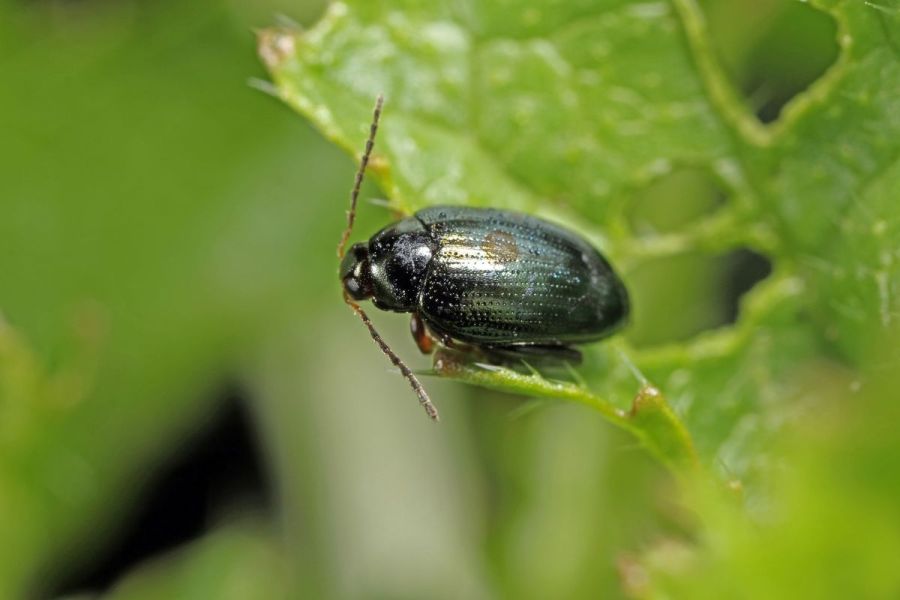Cabbage stem flea beetle management now requires a multi-pronged approach. CPM reports on an ongoing AHDB project that’s uncovering the best tactics to deploy.
“It’s so important to understand the pest if we are to manage it effectively.”
By Adam Clarke
The distress surrounding cabbage stem flea beetle (CSFB) as it caused huge swathes of oilseed rape to be written off over the past decade is understandable.
And although the pest is still causing severe headaches across the UK, an impressive research effort since the withdrawal of neonicotinoid seed treatments has done much to calm growers’ nerves.
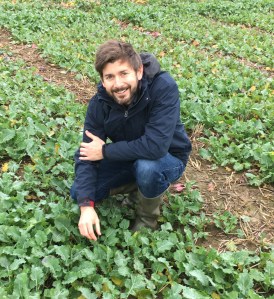
Different approaches are better suited to managing either adults or larvae, explains Sacha White.
A major AHDB-funded project has been integral to finding solutions and its lead scientist, ADAS entomologist Sacha White, urges growers to consider the whole suite of Integrated Pest Management (IPM) measures it has identified.
He believes the work has shown IPM can succeed against the pest when all the available tools are stacked together to protect vulnerable crops.
“Those tools should be selected based on sow date, as we know this informs the level of pressure experienced and the type of pressure, whether its adult, larvae, or both. Different approaches are better suited to managing either adults or larvae,” explains Sacha.
Based on the project learnings so far, variety choice is key to any situation OSR is being drilled into and their characteristics must match with the pressures the crop is likely to face. Sacha says the start, peak and end of migration do vary between locations and years.
Data is currently being analysed to see if there are relationships between these events and factors such as weather and crop growth stage. However, until these can be clarified and honed, the rule of thumb remains that adult migration tends to intensify around the final week of August into early September, he says.
“So, if you are sowing a crop from the third week in August, you need a variety with good autumn vigour to grow away from adult feeding.
“There is also an increasing body of evidence that companion crops reduce pest numbers and damage. Work we’ve done as part of this project looked at buckwheat, berseem clover and fenugreek, alone and in mixtures,” explains Sacha.
This showed there is significantly less damage to OSR at the two-leaf and five-leaf stages when companion-cropped. However, advice is to choose one that won’t outcompete the crop and can be removed easily, either killed by frost or taken out with a post-emergence herbicide.
Much has been made of drilling date and seed rate, with growers and agronomists largely divided into two camps – early to get plants away before adult migration, or late to miss the peak of migration.
Either path comes with its inherent risks. Early drilled crops can suffer from lack of moisture, slowing emergence and reducing establishment. Crops can also become too forward and trickier to manage later in the season.
Later drillings can also suffer from slow establishment if the weather turns cold and wet, but there are clear benefits if they get away unscathed.
“Drilling in the second half of September may result in the crop emerging after the migration peak, reducing the threat from adult beetle feeding. Those crops are also associated with reduced larval pressure,” says Sacha.
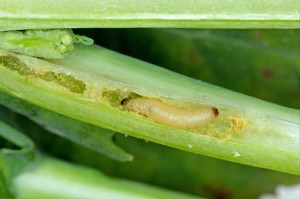
The trials results suggest that a three-week delay in sowing may result in a 10-fold reduction in larval load.
Eggs are laid at the base of plants once adults finish feeding, typically from late October, and a few weeks later the emerging larvae tunnel into leaf petioles to feed during the winter and into spring.
When crops are established later, the process of egg laying and development is slowed as conditions cool, he explains. “Our trials results suggest that a three-week delay in sowing may result in a 10-fold reduction in larval load. We also found a significant yield increase in a crop drilled on 26 August and one drilled on 15 September,” explains Sacha.
However, he adds the caveat that results from field trials were variable and should be treated with caution. To iron out this variability, caused by other factors influencing plant and pest development in the field, the project is conducting larval feeding experiments in controlled conditions. This involves three different pot test protocols.
The first is looking at the impact of larvae numbers on crop development outcomes, with larvae introduced to individual plants at 0, 5, 10, 20 and 40 larvae per plant.
The second is investigating the effect of crop growth stage on larval impact, with the hypothesis that more mature plants can better tolerate crop damage. With late larval invasion of crops more common, a better understanding is required, says Sacha. This experiment will load plants with 0, 10 and 20 larvae per plant at three growth stages – BBCH 12, 18 and 24.
Finally, the influence of stem width on larval impact will be investigated after field trials suggested that thicker stemmed OSR plants can tolerate high larval populations and still achieve high yields. The third experiment will therefore introduce two larval loads of 0 and 20 per plant to three different stem widths to see if there’s any evidence to back such observations.
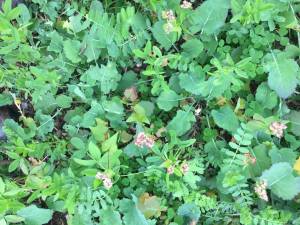
The project has shown significantly less damage to OSR at the two-leaf and five-leaf stages when companion-cropped.
“Is it possible that plants with thicker stems can cope better? If true, it would suggest that crops could be managed to improve tolerance,” explains Sacha.
In all experiments, second instar larvae will be introduced to the plants and initially kept in a controlled environment to maximise invasion success, before being moved outside to conditions more representative of those a crop might face.
“The plants will be assessed for growth stage, plant height and stem width regularly, before finally being destructively assessed for internal damage and biomass. Plants in some experiments will also be assessed for stem strength. Results will be in the final report later this year,” says Sacha.
Work at Harper Adams University by Dr Tom Pope has also been looking at the feeding preferences of CSFB adult using OSR seedlings at different growth stages: cotyledon, one true-leaf and two true-leaf.
In the first of these experiments, adult beetles were offered OSR cotyledon, first and second true-leaves in enclosed arenas, and they ate a greater surface area percentage of cotyledons.
However, the adult beetles actually seemed to prefer eating the second true-leaves, munching a much greater area of leaf, even though this area represented a lower percentage of the total leaf area.

Dr Tom Pope
Tom says it’s a work in progress, but they hope to pinpoint the exact stage when OSR plants are most attractive to beetles, adding another layer of information to base drill date decisions upon.
Although beetles eating cotyledons could potentially kill the plant, if adult females are eating more at the second true-leaf stage, the beetles could be healthier, lay more eggs and thereby increase larval pressure, he suggests.
“The plant might survive that better in the short term, but then get nobbled by larvae later. It all feeds into Sacha’s work on identifying risk windows and timing it so the crop is outside of those windows when it’s at its most vulnerable or most attractive.
“We’re also trying to understand the mechanisms that determine any feeding preference for different aged plants. The assumption is that they use smell to identify their preferred food. We can test this by removing the plants and just offering adults the smells of seedlings at cotyledon, first and second true-leaf stages,” explains Tom.
He suspects the reason adults show a preference for a particular growth stage is due to subtle changes in the chemical composition of the plant material, such as glucosinolate levels.
“What is going on is quite complicated, but it’s so important to understand the pest if we are to manage it effectively, particularly in the absence of effective insecticides,” adds Tom.
Alongside drilling date, seed rates have been debated amongst growers and advisers, with some opting to sow high rates of farm-saved seed to get enough plants through the adult migration peak by diluting feeding damage.
Interestingly, however, higher seed rates are associated with higher numbers of larvae per hectare and that could exacerbate the problem in future crops.
Sacha says that, generally, increasing the seed rate beyond what’s required to achieve the optimum plant population of 25-40 plants/m2 results in little yield benefit, unless conditions are very dry at establishment.
“Decreasing the seed rate may produce larger plants more tolerant of larval feeding in spring, but that’s something we hope to clarify with the larval feeding experiments.”
Other practical steps to consider as part of an IPM strategy include cultivation method, with low soil disturbance systems helping to retain moisture and improve establishment in drier autumns.
Sascha says based on anecdotal evidence, CSFB may be attracted to disturbed soil, but there is little robust scientific evidence to back that theory so far. Similarly, early nutrition is thought to be important in getting crops established to the four-leaf stage, beyond which the impact of adult feeding is no longer considered a threat to survival.
Some farms have successfully used starter fertilisers at establishment, along with the use of organic materials like digestate. The industry could well benefit from more research into these areas, highlights Sacha, alongside managing the farmed environment to encourage natural enemies like parasitic wasps while deploying biopesticides like entomopathogenic fungi that infest and kill adult beetles.
“IPM isn’t straightforward, so developing decision-support systems that can help predict when pest events are happening and guide what interventions are required could be very helpful,” he adds.
OSR establishment guidance cracked
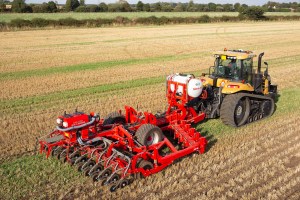
It can spread risk if you drill a proportion of the crop at an early and a late timing, particularly if you have a large area,” says Rob Nightingale.
Thanks to the significant research efforts of recent seasons, Frontier Agriculture’s technical sustainability specialist, Rob Nightingale, hopes conversations will now shift back to optimising yield from guaranteeing establishment.
The crop production and grain marketing company has been a key industry partner in the project, contributing to the pool of data used to tease out the best CSFB management tools.
This has come from CSFB catches at its multiple field-scale trials dotted around the country, building a picture of the pest’s lifecycle over many years, along with strip trials comparing cultural measures – like companion crops or planting into longer stubbles, says Rob.
“From the project, I think we, as an industry, can come up with some very good guidance on how to best mitigate against the pest. For a long time now, conversations with growers centred around getting the crop established rather than factors that help improve yield.
“Now we can get back to things like macro- and micronutrition, canopy management and disease control to help achieve the crop’s full potential,” he explains.
Three elements of the project have made a lasting impression on him, the first related to the CSFB lifecycle. Much of the previous work was carried out back in the 1980s, when the crop area was just 50,000ha, he points out.
It peaked at about 700,000ha in 2012 and although it has since fallen to 323,000ha, this significant increase in area has been accompanied by milder winters.
“It’s been important to revisit the lifecycle work and put it into the context of today’s OSR production. It’s clear the warmer winters are leading to more larvae damage and we are also seeing a huge adult migration in the first two weeks of September.
“I’m a fan both early drilling and late drilling to avoid peak adult migration, and late drilling can reduce larval pressure. It can spread risk if you drill a proportion at each timing, particularly if you have a large area,” says Rob.
The second point has been seeing how results have been measured – in field-scale, small plot, and controlled trials – before data is analysed to see what each control tactic brings to the party.
Rob says that sometimes people want and expect IPM strategies to be like a spray which quickly gets rid of the problem, but the project shows it’s all about stacking odds in the crop favour by 5% or 10% here and there.
“It’s been interesting to follow how things work, and how the research ruled a few things out too. One example is high seed rates, which leaves you with thick, thin-stemmed crops and could be breeding more larvae.
“It’s best to stick with seed rates for an optimum plant population of about 35 plants/ha. If you’re in a real hotspot, you might increase it by 5-10%, but no more than that,” he explains.
Finally, Rob says insecticide sprays should only be used with great care and once the strengths, weaknesses and potential impact on beneficial insects have been considered.
“Pyrethroids might do a job on certain populations, but not on others. However, it’s very difficult to get that resistance information in time to inform spraying decisions,” says Rob.
Research roundup
From Theory to Field is part of AHDB’s delivery of knowledge exchange on grower-funded research projects. CPM would like to thank AHDB for its support and in providing privileged access to staff and others involved in helping put these articles together.
For further info:
AHDB Project 21120185: Reducing the impact of cabbage stem flea beetle (CSFB) on oilseed rape in the UK is led by RSK ADAS, with scientific partner Harper Adams University. The project has a total value of £550,520. AHDB Cereals and Oilseeds contributed £240,000, with the rest from industry partners. These include BASF, Bayer, Cotton Farm Consultancy, DSV, Elsoms, Frontier, Innovative Farmers, KWS, Limagrain, Syngenta, Tuckwells, United Oilseeds and Yara. Project reports can be found here.
This article was taken from the latest issue of CPM. For more articles like this, subscribe here.
Sign up for Crop Production Magazine’s FREE e-newsletter here.

